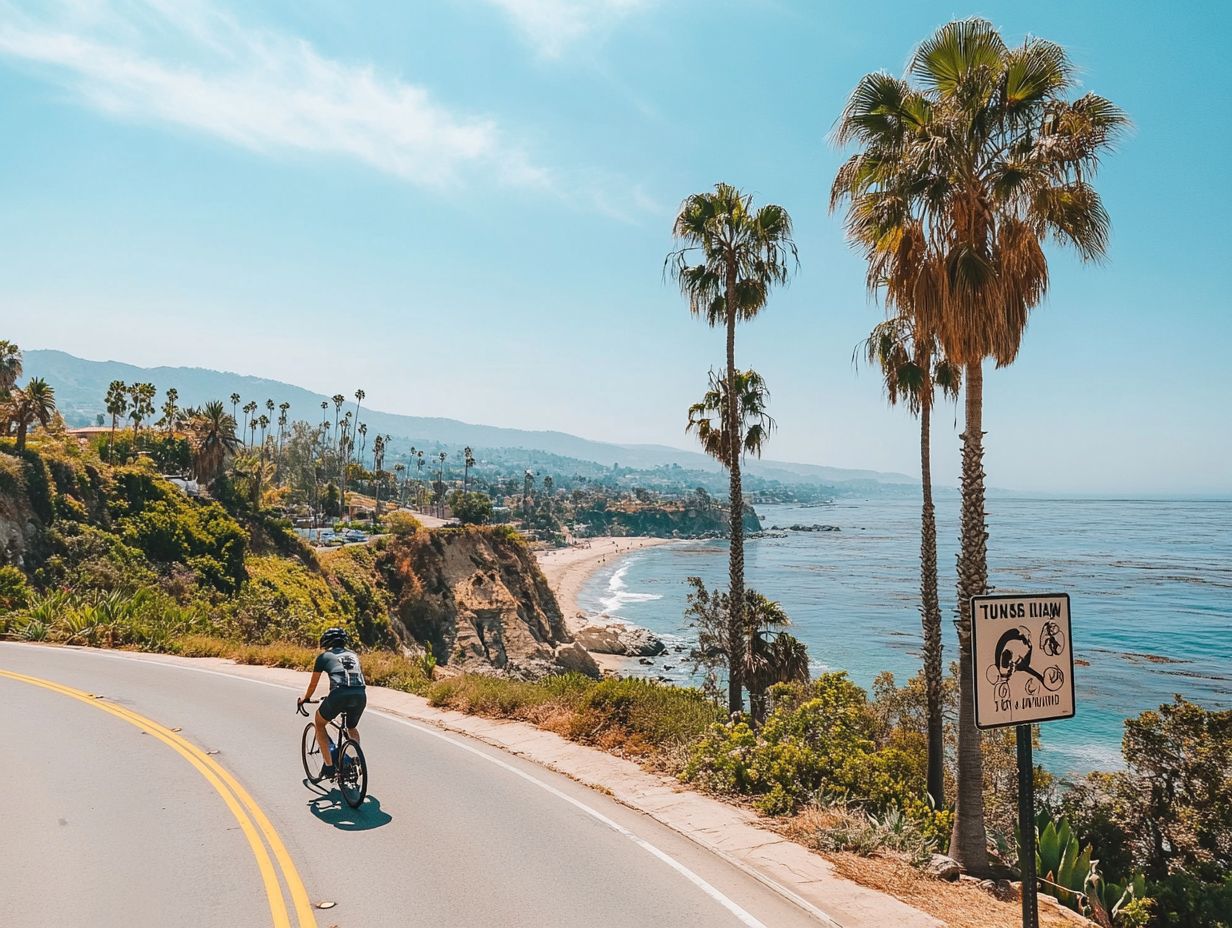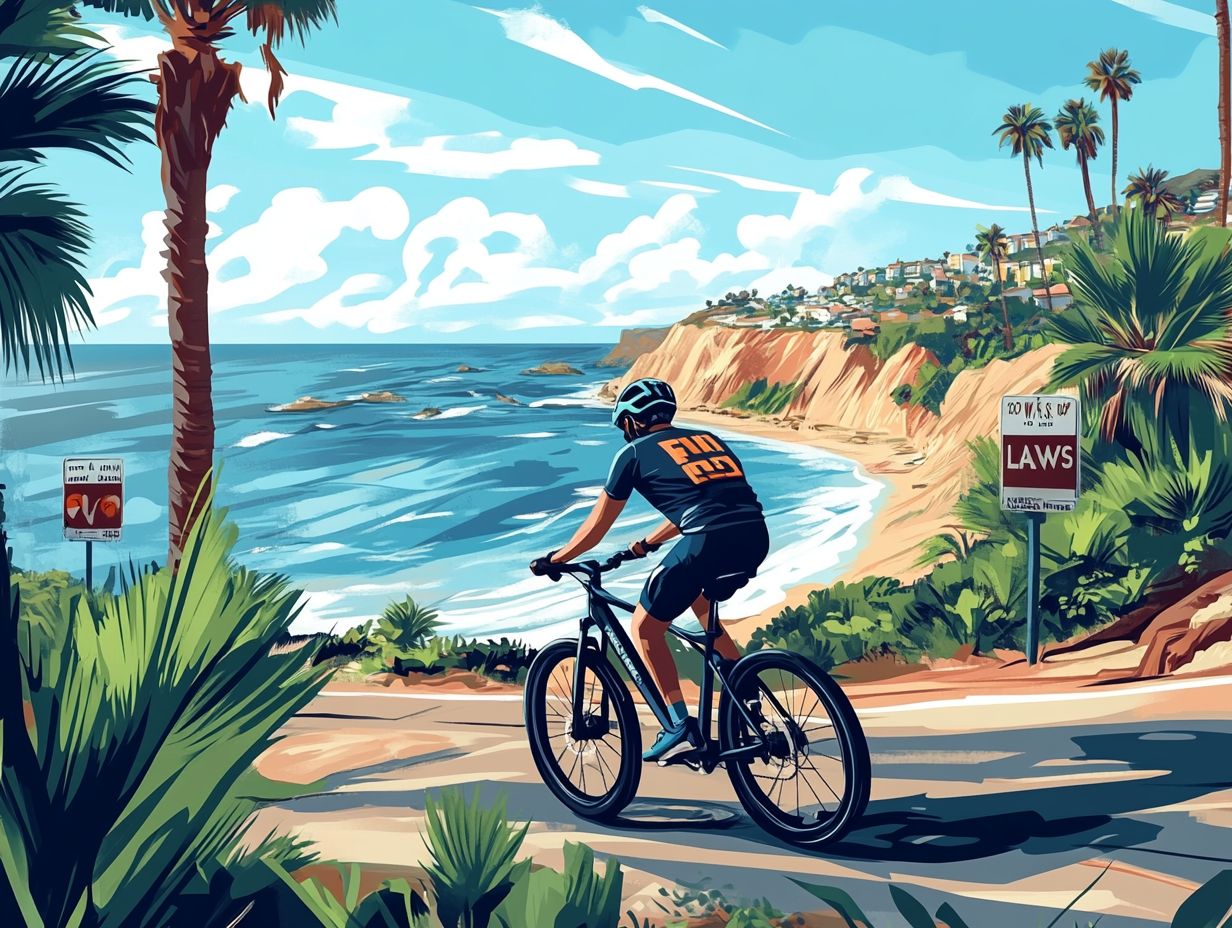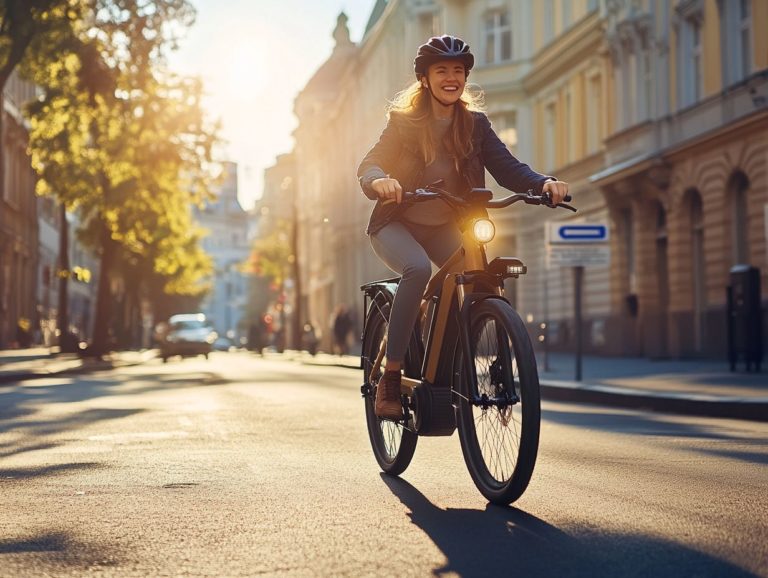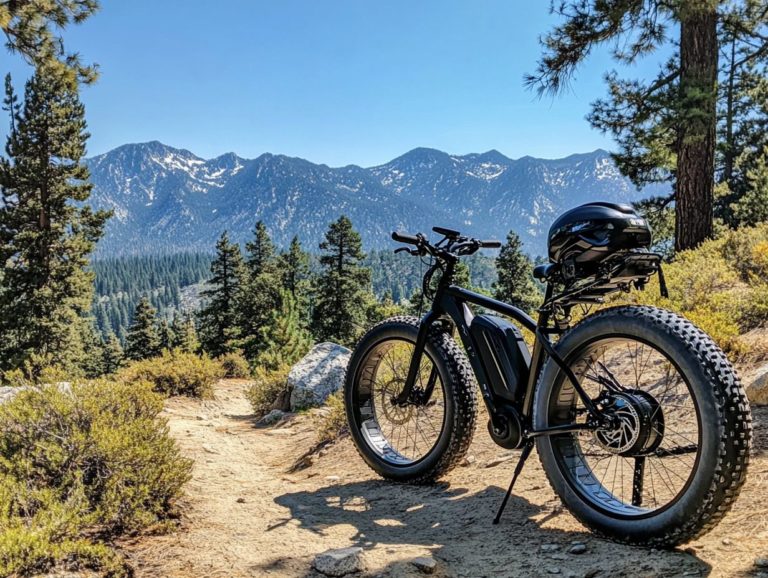Understanding Electric Bicycle Laws in California
Electric bicycles have emerged as a favored choice in California, offering a sustainable alternative to conventional modes of transportation.
As their popularity grows, so does the necessity to grasp the laws that regulate their use. This article delves into the intricacies of electric bicycle regulations in the Golden State, covering everything from classifications and licensing requirements to the areas where you can legally ride.
It also covers safety regulations and the repercussions of violations, ensuring you are thoroughly informed before you embark on your journey.
Contents
- Key Takeaways:
- Understanding California’s Electric Bicycle Laws
- Classification and Requirements
- Where Electric Bicycles are Allowed
- Safety Regulations for Electric Bicycles
- Fines and Penalties for Violations
- Frequently Asked Questions
- What is an electric bicycle?
- Do electric bicycles require a license to operate in California?
- What are the criteria for an electric bicycle to be classified as a bicycle in California?
- Are there age restrictions for operating an electric bicycle in California?
- Are there any restrictions on where electric bicycles can be ridden in California?
- Are helmets required for riding an electric bicycle in California?
Key Takeaways:

- Electric bicycles are defined as bikes with a motor under 750 watts and a top speed of 20 mph or less in California.
- Electric bicycles are classified into three categories and have specific registration and licensing requirements depending on the class.
- Electric bicycles can be ridden on designated bike lanes and paths but may be restricted on sidewalks and roads depending on local regulations.
Understanding California’s Electric Bicycle Laws
The landscape of electric bicycle laws in California has transformed remarkably, largely thanks to the California Assembly Bill No. 1096. This legislation is designed to enhance the regulation and safety of electric bicycles, or e-bikes, throughout the state. It addresses various facets of e-bike use, including classification, legal rights, restrictions for riders, and following California’s vehicle rules, ensuring that both you as a rider and manufacturers meet established standards.
With a strong emphasis on promoting eco-friendly transportation, this law shows California’s dedication to a greener future! It encourages you to embrace electric bicycles as a responsible and sustainable alternative to traditional commuting methods. For more details on the specific rules, you can check the electric bicycle age restrictions by state.
What is an Electric Bicycle?
An electric bicycle, often called an e-bike, is a pedal-operated marvel equipped with an integrated electric motor that helps you pedal. This makes cycling more accessible for a wider range of riders, including those who might find traditional biking a bit daunting.
This innovative transportation option uses a system that helps you pedal, meaning the motor kicks in only when you re pedaling. This creates a natural biking experience, helping you conquer longer distances without the usual fatigue. Many e-bikes come with a grip on the handlebars that lets you speed up without pedaling, perfect for quick starts or tackling those challenging hills.
There s a variety of electric bicycles on the market, such as city e-bikes, mountain e-bikes, and folding e-bikes, each tailored for specific riding styles and environments. Unlike conventional motorized bicycles that often depend solely on throttle power, e-bikes ensure you still put in some effort while enjoying the added boost and versatility.
Classification and Requirements
Understanding the classification of electric bicycles in California is essential for navigating the legal framework that governs their use. These bicycles are categorized into three main classes: Class 1, Class 2, and Class 3.
Each class comes with unique characteristics and operating requirements, dictating where and how they can be used legally. This knowledge ensures that you remain compliant while enjoying your ride.
Different Classes of Electric Bicycles
In California, electric bicycles fall into three distinct categories: Class 1 e-bikes, which offer pedal-assist only; Class 2 e-bikes, which come with a grip on the handlebars that lets you speed up; and Class 3 e-bikes, capable of reaching higher speeds with pedal assistance, each with their own set of regulations.
Grasping these classifications is essential for both riders and manufacturers, as they determine where and how you can legally ride. For a comprehensive overview, check out electric bicycle laws: a comparison between states.
- Class 1 e-bikes are capped at a maximum speed of 20 mph and only operate when you’re pedaling, promoting a healthier riding experience.
- Class 2 e-bikes share that same top speed but can also be powered solely by a throttle, making them an appealing option for those who prefer a more effortless ride.
- Class 3 e-bikes can zip up to 28 mph and must include a working speedometer, along with specific regulations that require helmet use for riders under 18.
These distinctions are designed to ensure safety and provide clear guidelines for various cycling experiences.
Get ready to ride and enjoy the benefits of electric biking today while ensuring you know how to stay compliant with electric bicycle laws!
Registration and Licensing Requirements

While electric bicycles typically don t require registration or a special license in California, it s crucial for you to grasp the minimal requirements for certain classes. This understanding is vital for both e-bike manufacturers and riders to follow local laws.
Take Class 3 e-bikes, for instance. These are fast electric bikes that can reach speeds of up to 28 miles per hour. These models may come with their own set of mandates. Local ordinances might specify that these high-speed e-bikes can only be used on designated bike paths and certain roads, which affects where you can legally ride them. To stay informed, it’s crucial to understand the top electric bicycle laws every rider should know.
As a manufacturer, you must stay aware of these local regulations; failure to do so could lead to legal disputes or increased liabilities. This situation emphasizes the importance of having a solid grasp of state and municipal codes for both producers and users. Navigating the world of electric biking effectively hinges on this knowledge.
Where Electric Bicycles are Allowed
Grasping where electric bicycles are allowed to operate is essential for a safe and compliant riding experience. California’s regulations outline specific areas for e-bikes, such as Class 1 Bike Paths, Class 2 Bike Lanes, and Class 3 Bikeways.
Be aware that local regulations may impose further restrictions on e-bike usage.
Designated Bike Lanes and Paths
In California, designated bike lanes and paths are categorized into Class 1, Class 2, and Class 3, each tailored for specific types of e-bikes, ensuring you can navigate safely through both urban and recreational spaces.
Class 1 bike paths are your personal oasis, exclusively for non-motorized bicycles. Here, you can revel in a peaceful ride, immersing yourself in the natural beauty without the distraction of motorized traffic. These lanes often grace parks or scenic routes, making them ideal for a leisurely escape.
Class 2 bike lanes are marked lanes on the road designed for cyclists. These lanes welcome Class 1 e-bikes, which offer pedal assistance but no throttle. Typically found in urban areas, they are essential for commuting and connecting you to local amenities.
Class 3 bike routes expand your options, allowing a wider array of e-bikes, including those equipped with throttles. You ll often discover these routes in less congested areas, perfect for your adventurous spirit.
Explore the stunning coastal paths in Santa Monica or the breathtaking routes around Lake Tahoe for an unforgettable biking experience! These destinations beautifully illustrate the diversity of California’s biking landscape, providing cyclists of all kinds the opportunity to experience the state s unique terrains.
Restrictions on Sidewalks and Roads
Electric bicycles come with specific restrictions regarding sidewalk and road use. It s crucial for you to understand these rules to comply with traffic laws and steer clear of any penalties.
In many urban areas, certain e-bikes may be outright banned from sidewalks, especially in pedestrian-heavy zones. Instead, you’ll need to navigate designated bike lanes or roads designed for motor traffic. For detailed information on the state-specific electric bicycle legal frameworks, these regulations protect cyclists like yourself and ensure pedestrian safety.
Some municipalities even impose speed limits on e-bikes, requiring you to adhere to local traffic laws. Ignoring these rules could land you with fines or other legal consequences, highlighting the importance of staying informed about electric bicycle safety regulations while you enjoy the many perks of electric biking.
Safety Regulations for Electric Bicycles
Understanding safety regulations is not just smart; it’s essential for your well-being! Safety regulations for electric bicycles are crucial for preventing accidents and injuries.
You should be aware of the requirements for protective gear, helmet use, and the implementation of safety equipment specifically designed to enhance your riding safety, whether you’re commuting or enjoying a leisurely bike ride.
Helmet and Lighting Requirements

California has set specific helmet and lighting requirements for electric bicycle riders. These regulations aim to enhance safety and minimize the risk of accidents on the road. This ensures you, as a rider, have the appropriate protective gear.
If you’re under 18, you must wear a well-fitting and securely fastened helmet. While adults aren t legally required to wear one, it s strongly encouraged. When riding at night or in low visibility, using front lights and rear reflectors is essential to alert other road users to your presence.
These provisions promote responsible riding practices and significantly enhance your visibility and safety as an e-bike rider. Following these laws is crucial for avoiding potential hazards and ensuring a safer experience on the road.
Speed Limits and Traffic Laws
Electric bicycles have specific speed limits and traffic laws, similar to traditional bicycles. This ensures you have a safe and enjoyable riding experience on public roads and biking trails.
The speed limits for various classes of e-bikes are key to fostering responsible riding. These classes are often categorized by motor power which refers to how strong the electric motor is and maximum assisted speeds. For instance, Class 1 e-bikes cap at 20 mph and require you to pedal to engage the motor assistance. It’s also important to understand the licensing requirements that ensure compliance with local regulations. This creates a balance between efficiency and safety.
Conversely, Class 3 e-bikes can reach speeds up to 28 mph, but you may encounter additional requirements, like helmet laws in certain areas.
Understanding these classifications and their corresponding traffic regulations is essential. This knowledge ensures your safety and promotes a more harmonious coexistence with other road users.
Fines and Penalties for Violations
Be aware breaking electric bicycle laws in California can lead to hefty fines and penalties. It’s important for riders to fully grasp the legal requirements and ensure compliance.
By understanding these regulations, you protect yourself from the potential consequences of non-compliance and enjoy your rides with peace of mind.
Consequences for Breaking Electric Bicycle Laws
The consequences of breaking electric bicycle laws can vary significantly. They range from fines to more serious legal repercussions. It’s essential for riders to be well-informed about their legal rights and responsibilities while operating e-bikes.
For example, riding an electric bicycle in a pedestrian-only zone could result in substantial fines, sometimes exceeding several hundred dollars. Similarly, failing to adhere to specific speed limits or neglecting to wear required gear can lead to citations and even higher insurance premiums.
In more severe cases, repeated violations could lead to legal actions that threaten your e-bike privileges or even require you to appear in court.
Therefore, understanding local regulations is crucial to avoid these penalties, ensuring not just compliance but also a safe and enjoyable riding experience.
Frequently Asked Questions
-
What is an electric bicycle?
An electric bicycle, or e-bike, is a bicycle with an integrated electric motor that can assist with propulsion. It combines elements of a traditional bicycle and a motorcycle.
-
Do electric bicycles require a license to operate in California?
No, electric bicycles do not require a license in California as long as they meet certain criteria set by the state.
-
What are the criteria for an electric bicycle to be classified as a bicycle in California?
An electric bicycle must have operable pedals, a motor with a maximum power of 750 watts, and a top speed of 20 miles per hour to be classified as a bicycle in California.
-
Are there age restrictions for operating an electric bicycle in California?
Yes, riders must be at least 16 years old to operate an electric bicycle in California.
Are there any restrictions on where electric bicycles can be ridden in California?
Excited to ride your electric bicycle? You can cruise on bike paths and trails in California, as long as local governments haven t set other rules. Just remember, no riding on sidewalks!
Are helmets required for riding an electric bicycle in California?
Safety first! Just like traditional cyclists, anyone riding an electric bicycle in California must wear a helmet. It s the law, and it keeps you safe on your rides!






